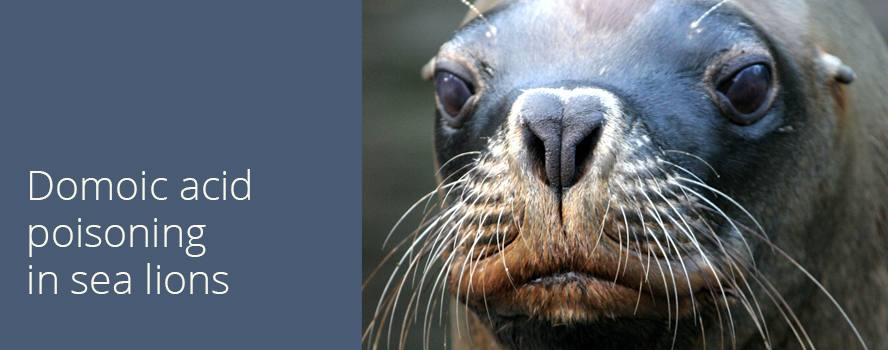Photo by Scott Lidell
Domoic Acid Poisoning in Sea Lions
by Helga George, Ph.D.
Domoic acid (DA) is a potent neurotoxin that can affect people, marine mammals, and birds. Under some conditions, such as when there is a large degree of pollution from nitrogenous run-off into the ocean, large build-ups of algae can occur. Such harmful algal blooms can produce toxins, including DA. Fish such as anchovies eat the algae, become full of toxin, and are themselves eaten by larger animals, such as sea lions. Sea lions poisoned by domoic acid suffer brain damage, behave erratically, and on occasion, are believed to attack people. This poisoning is frequently fatal.
Effects of domoic acid poisoning in sea lions
Domoic acid is a water-soluble amino acid-like compound that is a tricarboxylic acid. It is produced by species of the diatom Pseudonitzschia. Poisoning by domoic acid is the most important cause of disease and death in sea lions. It can cause them to have seizures, head waving, tremors, and scratching behavior. The part of the brain affected in mammals is in specific areas of the hippocampus, which are responsible for memory and learning.
The effects of domoic acid poisoning are due to its ability to act as a substitute for the neurotransmitter glutamate. DA also shares structural similarity with a neurotoxin known as kainic acid. Both glutamate and kainic acid are excitatory amino acids. When they bind to specific glutamate receptors, they cause stimulation of the nervous cells. The difference is that with glutamate, this stimulation dissipates over time. With the neurotoxins, it persists, causing over-stimulation. The binding of DA to the receptors causes an influx of calcium into the cells, leading to lesions and cell death in regions of the hippocampus.
Scientists describe a new type of poisoning of sea lions by domoic acid that they have been able to replicate in the laboratory (seizures). Exposure to DA as a fetus can affect behavior later in life. Harmful algal blooms are becoming more prevalent, and there is greater exposure of pregnant sea lions to DA. This compound becomes concentrated in the amniotic fluid, which retains the chemical. The fetus is subject to repeated exposure, although the effects do not manifest until later in life. Then, the animals have seizures and exhibit abnormal behavior.
Sea lion attacks on humans
Although they are an endangered species, the California sea lion populations have been greatly increasing in size, and their food supplies have been dwindling. As the animals come closer to shore in search of food, there is much more contact with humans than there was previously. For instance, in the San Francisco’s Fisherman’s Wharf, the sea lion population has gone from being a benign curiosity for tourists to being a menace for boats in the harbor (Harrell). Sea lions that have been fed fish scraps, then denied them, have become aggressive toward humans. A woman in Berkeley who worked on a boat was hospitalized after a sea lion bit a chunk out of her leg.
In California alone, there have been several attacks by lone sea lions that are atypical for the species (Anitei). One individual sea lion in particular attacked 24 swimmers in the waters off San Francisco, biting 14 of them. In Santa Barbara, a lifeguard was bitten three times while swimming at El Capitan Beach. Also, in Manhattan Beach, several people on the beach were attacked and one bitten by a sea lion that subsequently swam away. It has not been definitively proven, but scientists believe that these aberrant attacks were due to sea lions having been poisoned by domoic acid.
Domoic acid poisoning threatens sea lions
The potent neurotoxin domoic acid is produced by a type of harmful algal bloom. It acts by mimicking the binding of glutamate to receptors in the hippocampus. This causes brain lesions and cell death in the affected areas. Sea lions subject to domoic acid poisoning behave erratically and suffer from tremors and seizures. This condition is also thought to be the causal agent for several sea lion attacks against humans. Pollution caused by humans has increased the amount of harmful algal blooms, leading to an increase in domoic acid poisoning in sea lions. This syndrome has become the single greatest cause of death for sea lions (Shutterbug).
References:
Anitei, Stefan, Nov. 29, 2006, “Sea Lion Attacks on Humans,” Softpedia.com, accessed May 2010
Harrell, Ashley, Oct. 7, 2009, “Too Cute to Shoot?,” SFWeekly.com, accessed May 2010
ScienceDaily.com, June 19, 2008, “Toxic Algal Blooms May Cause Seizures in California Sea Lions,” accessed May 2010
Shutterbug.ucsc.edu, “Domoic acid,” accessed May 2010
Zaccaroni, A. and D. Scaravelli, 2008, “Toxicity of Sea Alga Toxins to Humans and Animals,” pp. 91-158 in Algal Toxins: Nature, Occurrence, Effect and Detection, V. Evangeliste et al., editors. Springer, Dordercht, The Netherlands, Scribd.com, accessed May 2010
QUICK LINKS TO ALL
Suite.io Articles
by Helga George, Ph.D.
AGRICULTURAL SCIENCE
• Polyphenol Oxidase Enzymes Cause Browning of Fruits and Vegetables
CHEMICAL ECOLOGY
• Domoic Acid Poisoning in Sea Lions
• Insects that Make Cyanide
PLANT PATHOLOGY
• Plants Produce Chemicals as a Defense Against Pathogens
• Wheat Rust Threatens World’s Wheat Crops
• Biotrophic Versus Necrotrophic Fungi
• Fungal Haustoria Absorb Nutrients from Living Plant Cells
• The Gene-for-Gene Concept: a Central Tenet in Plant Pathology
GARDENING
• Oenothera speciosa—a Drought Tolerant Perennial Groundcover
• The Magic Lily—a Drought Tolerant Species of Lycoris
SOIL MICROBIOLOGY
• Streptomyces, Antibiotics, and Microbial Conflict in the Soil
AGRICULTURE IN SANTA BARBARA COUNTY
• Chrysanthemum White Rust Outbreak in Southern California

